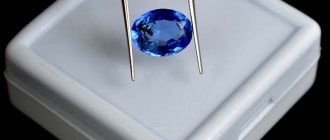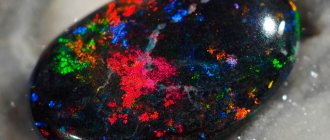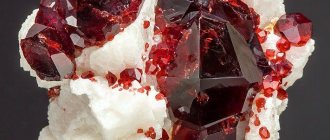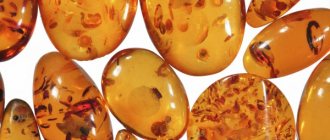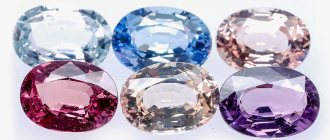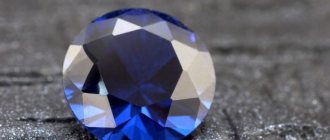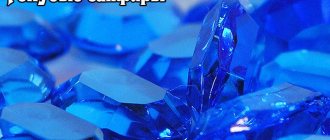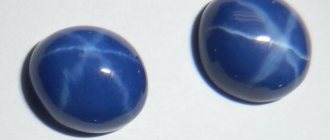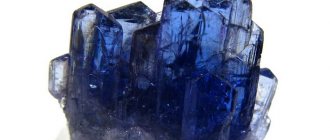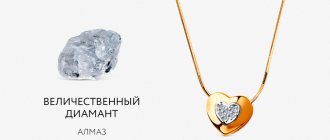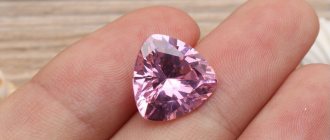Sapphire is a precious mineral of the first group, which is on the same level as diamond, emerald, and ruby. In terms of price, only a diamond is ahead of it. That is why they try to counterfeit this mineral more often than others. How to distinguish real sapphire from synthetic one, and is it possible to do this at home?
Appearance of the gem
Sapphire is a subtype of corundum. Initially, this stone has different shades of blue, from bright blue to purple. There are also yellow, powdery, green and amber-colored gems. In terms of chemical components, it is aluminum oxide, the structure of which contains impurities of iron and titanium. It is due to these components that the stone has a rich blue tint. The mineral is distinguished by its rigidity and refractive power, which gives it a pronounced shine.
The unprocessed mineral is distinguished by its uneven outline and color intensity. It is processed using a variety of methods. The most common are the facet cut and the cabochon technique, which makes the surface of the mineral smooth and smoothes out the edges. The facet cut is different in that it can be used to give the stone a variety of shapes, for example, a heart, a triangle or an octahedron. It is this type that is most often used for processing star sapphires, the structure of which contains rutile. The most valuable gemstones are deep blue, the shade of which is close to cornflower blue. Pale blue and dark blue minerals are not valued as highly.
Attention! Red sapphires do not occur in nature. Corundum, which has a rich red and garnet hue, is called ruby.
Areas of application
In addition to the jewelry industry, nanosapphires are also used in other areas:
- Medicine . Leucosapphires are used as a material for the manufacture of surgical blades, artificial eye lenses, optical elements of diagnostic devices, and braces in dentistry.
- Optical industry . Nanosapphire is a raw material for the production of large-sized optics, protective glasses, lenses, and prisms.
- Instrument making . The synthetic mineral is used as substrates for semiconductor microcircuits and optoelectronic devices.
- Laser technology . The mineral is used to produce titanium-sapphire lasers and amplifiers.
- Aviation and Rocket Science . The hard stone is used to make thin, impact-resistant glass for aircraft and space station windows.
In construction, sapphire is used to produce new generation thermal insulation materials.
Features of artificially grown samples
Jewelry is rare in nature, which is why its value is constantly growing. The price of substitutes produced in laboratories is significantly lower. At the same time, only a professional can distinguish a fake from a natural gem. That is why synthetic analogues are in particular demand and popularity.
Externally, the synthetic mineral is also not very different from the natural one. And thanks to modern manufacturing technologies, the product can be given virtually any shade and saturation. Hydrothermal or nanosapphires are grown from scratch or made from corundum. You can give them the desired tone using coloring. The chemical component of natural and artificially grown pebbles is aluminum oxide. They also do not differ in Mohs hardness (9 out of 10 points).
Post-cultivation treatment
To prevent cracking, the resulting sapphires are subjected to post-growth annealing in special installations. Subsequently, they are given the desired shape using laser grinding and polishing with suspensions and pastes. Due to the fragility of the material, processing using lathes, drilling and grinding machines is not used.
Synthetic sapphires are colored and refined using various technologies: diffuse treatment with metal salts, heating, and ultraviolet irradiation.
Market analogues of sapphire
Several types of imitations of natural corundum can be found on sale. Conventionally, they can be divided into the following groups:
- cheap fakes (usually made from painted glass);
- stones grown in laboratories;
- doublets;
- natural minerals of low cost.
You can distinguish real sapphire from artificial sapphire using general identification methods.
Fakes
It is not uncommon to find jewelry in which sapphire is replaced with ordinary glass. It will not be difficult to recognize such a crude fake. If you examine such a “stone” under a magnifying glass, small bubbles will be visible in it. It is also worth considering that the glass immediately heats up in your hands. It takes a long time to heat a sapphire to body temperature.
Doublets
Doublets are composite stones made up of several layers. In such a mineral, real sapphire usually acts as the top layer, and an artificial crystal or cheap gem is glued underneath it. Such gluing can be distinguished only with the help of a magnifying glass. Doublets are often used together with damaged stones when it is necessary to hide the problematic part of the product.
Artificial analogues
Growing artificial analogues is the only official way to obtain gems. The most popular is the Verneuil technology, in which crystals are obtained by mixing corundum chips, titanium, chromium and iron under high pressure. The coloring elements are usually nickel, magnesium or cobalt oxide. Such crystals are used not only in jewelry, but also in medicine and technology.
On a note! High-quality artificial corundum not only looks like the original, but in terms of quality characteristics it can even outperform natural gemstones.
History of creation
The first attempts to create artificial sapphire were made by the French chemist Auguste Verneuil in 1886. After 16 years, he managed to obtain a single crystal by melting metal oxides in a burner fire at a certain temperature and then cooling them.
Later, Verneuil's home laboratory turned into industrial production, which began to produce up to 3 tons of corundum per year. This method of producing artificial stones, called the Verneuil method (process), is still used to this day.
How to distinguish natural stone from artificial
Despite the fact that it is quite difficult to distinguish a natural sapphire from an artificial one, if you have certain knowledge, it is still possible to identify the authenticity of the stone. It should be taken into account that the artificial analogue is not only similar in appearance to natural stone, but also practically does not differ in physical properties. How can you test sapphire at home, and how effective are such methods?
It is important to know! Natural sapphire is one of the hardest minerals. It is capable of leaving marks on any other stone except ruby and tungsten carbide.
Mechanical impact
The natural mineral has smooth edges and sharp corners; in hardness and strength it is second only to diamonds. Therefore, it can only be damaged or scratched using a stone of the same hardness. At the same time, sapphire easily scratches any other surfaces, for example, tempered glass. It is recommended to carry out such an experiment on an inconspicuous area of the mineral.
You can also identify sapphire using the following methods:
- measurement with a refractometer. For a real mineral, the refractive index varies between 1.762-1.778;
- placement in monobromonaphthalene. After placing the jewelry in the liquid, the container should be placed against the background of a white sheet. A real stone will produce colored straight stripes on a sheet, while an artificial one will produce curved ones;
- a natural mineral does not change hue under ultraviolet light, while a grown analogue glows white or a faint greenish color.
It is worth considering that you can find out the authenticity of a mineral only using the first 2 methods, which are carried out only in laboratory conditions, with the appropriate equipment.
Foreign matter analysis
Natural sapphire differs from artificial sapphire in that it takes several thousand years to form. This feature affects the external properties of the stone. If you examine a star sapphire under a magnifying glass, foreign inclusions will be visible in it, and you will also be able to see the heterogeneous structure of the mineral. These features will be especially noticeable in bright sunlight. It is also worth considering that a natural gem cannot contain gas bubbles, which are typical for bottle glass.
The easiest way to distinguish natural specimens with the effect of asterism, which contain inclusions in the shape of a six-pointed star. When a natural stone is slowly turned, the star will move, while for an artificial one it will remain in the center. Today it is impossible to fake such an effect.
Color
A real sapphire differs from a fake in that its shade does not change, regardless of lighting. That is why, when conducting an examination, the bead is always carefully examined under natural light, and then under bright lamps. If the shade of the supposed jewelry changes, this indicates a fake.
Precious stones are always issued with appropriate quality certificates. If the document indicates that the stone has undergone heat treatment, it is checked under ultraviolet light. The synthetic mineral will have a slight greenish tint, while the natural one will have white highlights.
Formal methods
It is almost impossible to independently determine the authenticity of a sapphire and distinguish it from the same colored cubic zirconia or zirconium without the necessary skills. It’s wiser not to take risks and involve specialists in the assessment process. As for certificates and mineral passports, you can study them yourself.
Verification of certificates and documents
To minimize the likelihood of counterfeiting, it is recommended to purchase jewelry only in well-known stores with an impeccable reputation. Such salons present a corresponding certificate for each gem. When purchasing, the seller must tell you how the stone was processed. To make the color of the mineral more saturated, they are often exposed to x-rays or heated at high temperatures. Natural pebbles are not afraid of such tests, but their synthetic counterparts become striped.
Invitation of an expert
The most reliable way to verify the authenticity of a stone is to engage an independent expert who will check the stone and make a preliminary conclusion right in the store. But it is worth considering that a final assessment of the origin of a stone is possible only with professional tools. You will have to pay for such a service, but compared to the cost of a natural insert, this is a trifle.
Jewelry with mineral
A variety of jewelry is made from synthetic sapphire:
- rings;
- tiaras;
- rings;
- necklace;
- pendants;
- brooches
The synthetic gem is distinguished by its bright colors and shine, has a noble appearance, and therefore requires the selection of an outfit. Light crystals look good on young girls, dark-colored stones look good on middle-aged women and men. Jewelry with a miniature insert is suitable for daily wear, while larger gemstones will be appropriate for going out. Examples of combinations of synthetic sapphire with wardrobe items:
- coffee evening low-cut dress, updo and blue necklace;
- pale pink classic suit with silver shimmer and pink earrings in silver;
- blue jeans, white blouse and purple bracelet;
- summer dress in boho style and green pendant in gold;
- burgundy jacket, black trousers and white brooch.
View this post on Instagram
Posted by Elsa_Anticolly_ (@elsa_anticolly_) Mar 18, 2022 at 1:47 am PDT
View this post on Instagram
Posted by Elsa_Anticolly_ (@elsa_anticolly_) Nov 9, 2022 at 10:39 PST
How to care for and store stone
Synthetic crystals are strong and durable and require care:
- The mineral is not prone to contamination; it should be washed 2-3 times a year. To do this, clean the crystal with a brush and baby soap, then rinse with warm running water. Wipe dry.
- Store separately from other jewelry. Due to its high strength, a synthetic gem can scratch and split them.
- Avoid prolonged exposure to direct sunlight. The product will become dull.
- The decoration must not be thrown or dropped. Despite the strength, microcracks appear in the stones, which leads to its destruction. Chips on the surface spoil the appearance.
To watch a video review of jewelry with this stone:
Useful tips for choosing a stone
Since many artificial analogues are very similar in appearance to natural corundum, in order not to make a mistake in choosing, when purchasing jewelry with sapphire, it is recommended to follow these recommendations:
- It is recommended to purchase products only with stones that do not change their color, regardless of lighting. In this case, preference should be given to minerals of a rich blue color, as they are considered the most valuable;
- the cost of a stone depends on its purity. The most valuable are the gems of the first group, inside of which you can notice minimal inclusions. It should be taken into account that the gradation includes 4 categories of mineral purity. The price of group 4 sapphires is the lowest; inclusions and foreign impurities in them are the most noticeable. In most cases, the cost of a stone is determined taking into account the shade of the mineral and its purity;
- Classically cut minerals are of the greatest value. A high-quality gem should have smooth and symmetrical edges, no matter what angle it is viewed from;
- Before purchasing a product, it is recommended to evaluate the strength of the stone. If after contact with a sharp object there is no damage left on it, this indicates that the mineral is really of high quality;
- carat Jewels weighing more than 10 carats are rarely found in nature. If the weight of the product significantly exceeds this value, the risk of purchasing a counterfeit increases.
Other imitations of natural corundum
Synthetic corundum is a structural analogue of a natural crystal, but differs from it in the chemical composition and content of microimpurities. From an aesthetic and practical point of view, it is the most acceptable copy of natural sapphire.
Natural imitations of opaque sapphire include specimens obtained from waste natural stones by gluing or pressing. This group also includes colored natural minerals of other rocks.
Cheap fakes are made from glass alloys, which contain metal oxides to obtain the desired color.
Opaque stones are imitated using colored plastics.
Verification methods that cannot be used
There is no point in checking the crystal by scratching the glass with it. Most gemstones leave scratches on the glass. To guarantee the authenticity of the sapphire, you can try to scratch its surface with a crystal having a hardness of less than 8 Mohs units - there will be no damage to the yacht. “Testing strength” with metal will also not give results - corundum is harder than any type of steel.
You cannot test it “for hardness” by rubbing it with sandpaper. Emery abrasive is made from artificial diamond or chemical compounds of similar hardness. It will spoil any gem, regardless of its nature.
Characteristic
The physical and chemical properties of artificial and natural minerals are the same. The crystals are aluminum oxide colored with chromium, titanium, and iron. They have a high hardness - about 9 points: more than topaz, but less than diamond - the hardest mineral. The color is often blue, less common are varieties with greenish, purple, pink, and golden hues.
The optical characteristics of stones are also similar to the properties of natural gems, but there are differences in the geometry of the growth zones of crystals and bulbs. Synthetic hydrothermal sapphire, obtained in a laboratory, does not contain cracks or chips, which allows you to make a clean cut. The mineral is not afraid of temperature or ultraviolet rays, as the color is more stable.
The popularity of artificial sapphires is due to the fact that it is actually not a fake, but a stone completely identical to natural one.
Advantages and disadvantages
Nanosapphires have their positive and negative sides.
The advantages of synthetic corundum include:
- smooth surface without cracks or foreign inclusions;
- saturated color;
- resistance to scratches, ultraviolet radiation, and most detergents;
- low cost.
The only disadvantages can be considered the laboratory origin of the stone and its ideal appearance. Awareness of authenticity is important to many people, so some imperfections in natural breeds will be an advantage for them.
Weight
The weight of the stone is calculated in carats (1 carat is a fifth of a gram). A large mineral has a mass of >1 carat, medium 0.99-0.3 carats, small ones 0.01-0.29. Accordingly, the more a mineral weighs, the more expensive it is.
Sapphire weight by size
| Stone shape | Size | Weight (carat) |
| Circle | 2 | 0.04 |
| 2.5 | 0.08 | |
| 3 | 0.15 | |
| 3.5 | 0.25 | |
| 4 | 0.35 | |
| 5 | 0.65 | |
| 6 | 1.00 | |
| 7 | 1.6 | |
| Oval | 5x3 | 0.35 |
| 6x4 | 0.6 | |
| 7x5 | 1.00 | |
| 8x6 | 1.5 | |
| 9x7 | 2.20 | |
| 10x8 | 3.10 | |
| 12x10 | 6.00 | |
| 14x10 | 7.25 | |
| Square | 2x2 | 0.06 |
| 3x3 | 0.25 | |
| 4x4 | 0.45 |
